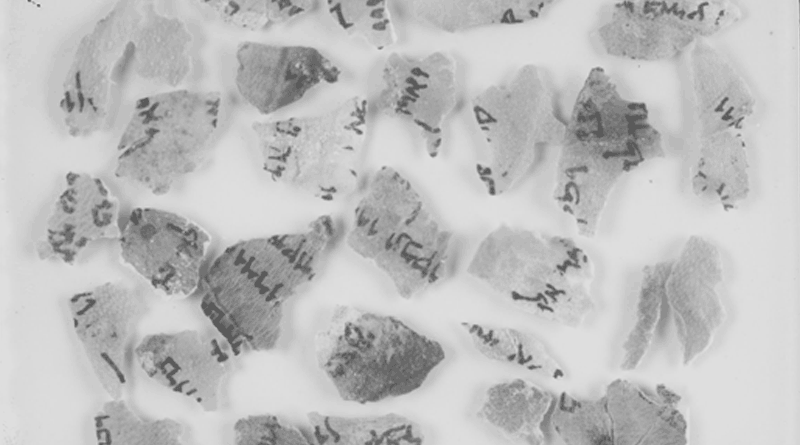When NT Apologists Make A Mess for OT Apologists

I noted earlier that the comparisons of Classical manuscript to the NT are in desperate need of an update. But even if we do take the time to update the numbers of the other classical works (as Jon recommended), we should be cautious about using them without very careful argumentation. If we aren’t careful, we might set the bar too high for ourselves.
Yes, the New Testament documents are peerless in terms of their dating and number, but the Old Testament documents are not.
One key column in the Meztgar/Geisler/McDowell chart is how many years separate the authorship of a work to it’s first known manuscript. And we tend to make a big show of the fact that the average distance is about 1,165 years. Then the conclusion is made, “See? The NT manuscripts are far closer to their authorship than any of the classical works. Therefore, the NT has a reliable transmission.”
And that’s very nearly true.
But a thoughtful person would raise a hand and ask, “But if the NT transmission is reliable because the manuscripts are so close to the authorship, then does that mean the OT isn’t reliable?”
And that’s a great question.
It’s a question made more forcefully when we premise it with the fact that the earliest complete Hebrew Bible dates to 1000 A.D.. Yes, you read that correctly. The earliest, complete Hebrew Bible is Codex Leningrad and its composition is dated to halfway through the Middle Ages.
“But David,” comes the objection, “Your forgetting about the extraordinary discovery of the Dead Sea Scrolls! They found a complete book of Isaiah and it matches the Masoretic Text exactly!”
Well, whenever I hear such enthusiastic claims, I’m always inclined to ask, “How do you know?” But in lieu of that, I think it’s worth noting that while the Great Isaiah Scroll was an amazing find that did match pretty closely to the text we had (though not “perfectly” or “exactly”), the book of Jeremiah was a full 15% shorter, as Wise, Abegg, and Cook explain:
The “Dead Sea Bible” is the oldest group of Old Testament manuscripts ever found–at least a thousand years older than the traditional Hebrew texts from the early medieval period that have been the basis of all our modern Bible translations. In many cases, the scrolls have supported the traditional text of the Bible, but, in others, what they say in particular verses (their “readings”) agrees with nontraditional versions like the Septuagint. (The Septuagint is the ancient translation of the Old Testament into Greek that was used among Egyptian Jews.) Sometimes the scrolls preserve readings we never knew existed.
At other times, the scrolls contain differences more profound than the readings of individual verses. They preserve “editions” of entire biblical books that differ from the traditional text. For example, two forms of the book of Jeremiah have emerged from the caves, one agreeing with that usually printed and translated in modern Bibles, the other about 15 percent shorter and with the contents in a different order.
Unfortunately, most lay Christians are going to assume that the text of the OT was copied by hand by scribes who did it so carefully that they burned copies with more than a certain number of errors and always washed their hands a lot and that’s why it doesn’t matter how many manuscripts we have for the OT because the copy job was so good. Honestly, I can’t be too hard on them; that’s just what they’ve been told.
We’ll maybe take a closer look at Jewish scribal practices some other time, but let’s stay focused on our argument from the number of manuscripts. Assuming that the oldest OT manuscript date is 50 BC (just for the sake of argument) and taking traditional authorship dates (again, just for the sake of argument), we we’d get something in the ballpark of this:
| Book | Date Written | Earliest Manuscript | Difference |
| Genesis | ~1445 BC | 50 BC | 1,395 years |
| Job | ~950 BC | 50 BC | 900 years |
| 1 Chronicles | ~530 BC | 50 BC | 480 years |
| Ezra | ~430 BC | 50 BC | 380 years |
The above isn’t intended to be definitive (that would be a much, much longer post) –but rather a simple, broad stroke to demonstrate what this standard argument for NT reliability looks like when applied to the OT. And therein lies the caution: in our enthusiastic defense of the NT, we must be careful that we don’t create an insurmountable standards for the Old Testament.
The truth is, the classical comparison was initially intended to prove we don’t need the stacks on stacks on stack of NT manuscripts in order to claim we have a reliable text. We just happen to have them. And there are many other texts most people are totally comfortable with that aren’t anywhere close to the NT’s collection.
Put another way, the NT is not reliable because we have a whole bunch of manuscripts that are ridiculously close to their time of authorship. Instead, the NT transmission is inscrutable because it far and away outshines its peers –and we consider its peers to be reliable. That’s the argument being made.
We’re blessed with unprecedented excess when it comes to NT manuscripts. So it’s critical that we not make that unprecedented excess the standard for reliability. Firstly, because it’s unnecessary and secondly because it’ll just make a mess for OT apologists who have to explain why the OT manuscript collection isn’t “as good” as the NT.

Member discussion